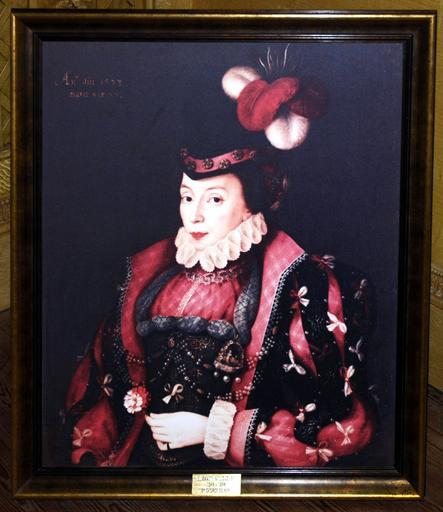MAKE A MEME
View Large Image

| View Original: | Elizabeth_Littleton,_wife_of_Francis_Willoughby.jpg (885x1024) | |||
| Download: | Original | Medium | Small | Thumb |
| Courtesy of: | www.flickr.com | More Like This | ||
| Keywords: indoor Sir Francis Willoughby (1547 – 1596) was an industrialist and coalowner, who built Wollaton Hall in Nottinghamshire. He was the son of Henry Willoughby, a Dorset landowner and Anne, daughter of Thomas Grey, Marquess of Dorset. Henry had inherited Wollaton from his uncle John Willoughby on 10 January 1549, but was killed in resisting Kett's rebellion on 27 August 1549. Francis became entitled to the family estates on the death of his elder brother Thomas in 1559. At the age of seventeen, he married Elizabeth Littleton of Frankley, Worcestershire. This proved to be a turbulent marriage and only produced daughters. Willoughby developed coal mines on his estate at Wollaton in the 1560s and 1570s. This enabled him to maintain a lordly lifestyle, maintaining a number of gentleman retainers. He employed Robert Smythson, who had previously worked at Longleat to build him a mansion, Wollaton Hall. By 1580, when his heir died aged six, he was separated from his wife. She offered to try for another heir, they remained separated and the queen arranged for her to have an allowance of £200 per year. He then decided to make his distant relative Percival Willoughby of Bore Place in Kent his principal heir, if he had no son, through marriage to his eldest daughter Bridget. This marriage took place in 1583, and several manors including Wollaton and Middleton, Warwickshire were settled on them in default of male issue. Willoughby entered into a number of speculative ventures, including growing and processing woad at Wollaton, and a plantation in Ireland. These took capital, as did his ironworks, at Middleton, Oakamoor (Staffordshire), and Codnor. The latter was his in consequence of the debts of Sir John Zouche. These were profitable, but Willoughby was unable to pay his debts as well as providing doweries for his other daughters. He accordingly handed them over in 1595 to Percival, who took responsibility for £3000 of the debts. This was followed by the death of his wife, with whom he had been reconciled. Willoughby immediately married a widow, but died only fifteen months later, leaving his widow expecting another child, who turned out to be another daughter. Percival thus inherited the estate, but encumbered with many debts. Sir Francis Willoughby (1547 – 1596) was an industrialist and coalowner, who built Wollaton Hall in Nottinghamshire. He was the son of Henry Willoughby, a Dorset landowner and Anne, daughter of Thomas Grey, Marquess of Dorset. Henry had inherited Wollaton from his uncle John Willoughby on 10 January 1549, but was killed in resisting Kett's rebellion on 27 August 1549. Francis became entitled to the family estates on the death of his elder brother Thomas in 1559. At the age of seventeen, he married Elizabeth Littleton of Frankley, Worcestershire. This proved to be a turbulent marriage and only produced daughters. Willoughby developed coal mines on his estate at Wollaton in the 1560s and 1570s. This enabled him to maintain a lordly lifestyle, maintaining a number of gentleman retainers. He employed Robert Smythson, who had previously worked at Longleat to build him a mansion, Wollaton Hall. By 1580, when his heir died aged six, he was separated from his wife. She offered to try for another heir, they remained separated and the queen arranged for her to have an allowance of £200 per year. He then decided to make his distant relative Percival Willoughby of Bore Place in Kent his principal heir, if he had no son, through marriage to his eldest daughter Bridget. This marriage took place in 1583, and several manors including Wollaton and Middleton, Warwickshire were settled on them in default of male issue. Willoughby entered into a number of speculative ventures, including growing and processing woad at Wollaton, and a plantation in Ireland. These took capital, as did his ironworks, at Middleton, Oakamoor (Staffordshire), and Codnor. The latter was his in consequence of the debts of Sir John Zouche. These were profitable, but Willoughby was unable to pay his debts as well as providing doweries for his other daughters. He accordingly handed them over in 1595 to Percival, who took responsibility for £3000 of the debts. This was followed by the death of his wife, with whom he had been reconciled. Willoughby immediately married a widow, but died only fifteen months later, leaving his widow expecting another child, who turned out to be another daughter. Percival thus inherited the estate, but encumbered with many debts. | ||||